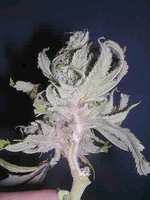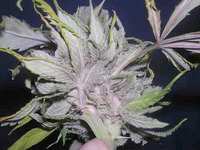Contributed by:
snoofer
Thanks to: TheHerbalCultivator (images), Jorge
Cervantes, vaaran
Submitted: Nov 1, 2004
Images
archived: 2004
Introduction 
Budrot (Botrytis) is a very common
worldwide fungus that attacks both indoor and outdoor
crops under certain conditions. Budrot is also known
as brown rot, grey mold and other names. Airborne
Botrytis spores can be found everywhere, all times of
the year, and will attack many different species of
plants. Botrytis will attack flowers, and eventually
leaves and stems.
Growers running sea of green,
perpetual harvest, remote grows, outdoor, or multiple
strains (each with different flowering periods) should
keep an eye out for Botrytis near harvest time.
Outdoor growers need to be hypersensitive to
weather conditions near harvest time. Rain, morning dew,
frost and cool fall nights may increase the risk of
budrot and powdery mildew.
Fully developed
marijuana buds provide ideal conditions for spore
germination: warm and moist plant tissues. Botrytis will
initially attack
the largest and densest buds in the
garden, because they provide the ideal conditions for
germination. Weak plants will also be attacked rapidly.
Identifying and preventing budrot

Budrot will infect and turn colas to mush
in a matter of days and may destroy a crop in a week if
left unchecked. Botrytis loves warm, and humid (50% or
over humidity) conditions. Lowering humidity will slow
and stop spore germination. Good ventilation and decent
air circulation help prevent infection.
A grow
room may smell noticeably moldy if Botrytis has attacked
one or more colas. Once a cola has been infected,
Botrytis will spread incredibly fast. Entire colas will
turn to brown mush and spores will be produced,
attacking other nearby colas.
Ventilation may
spread viable spores throughout the room.
Measures to prevent budrot in the final
stages of flowering:
Early veg and flower pruning of undergrowth to
promote air circulation
Hepa filter room and intake air sources.
Introduce low levels of ozone into room air. Ozone
is effective against pollen, podwery mildew and other
airborne spores.
Lowering room humidity (warming nighttime air and
venting frequently or using a dehumidifier)
Decreasing watering cycles and amounts to reduce
room humidity
Large, dense colas should be periodically inspected.
Brown tissues deep within the bud will smell moldy and
may become liquid.
Removing fan leaves during the last few days before
harvest to promote air circulation
Serenade (thanks vaaran)
"Serenade
controls the following: ....Botrytis, Powdery mildew,
Downey mildew..."
"Certified organic by OMRI and
EPA/USDA National Organic Program, Serenade offers
growers the luxury of application without weather or
timing restrictions and there are no phyto-toxicity
issues"
"To apply, simply spray on leaves and
shoots to provide complete coverage. Best results will
be had be pre-treating plants before signs of disease
set it and then every week to protect newly formed
foliage"
What if budrot is found?
Once budrot has been detected, the grower should
isolate infected buds by removing them from the growroom
immediately and harvesting the infected colas, followed
by a rapid dry of the harvested colas. Take immediate
steps to reduce room humidity. Afterwards, the entire
crop should be carefully inspected for infection and
damage.
The grower may want to harvest early if
more than one rotting cola has been found. Spores may
have spread and are germinating deep within other colas.
Can I salvage budrot-infected colas?
Yes. Remove the infected colas from the main
room, Trim out the infection (Trim more than you can see
Botrytis often infects adjacent tissues) and quick-dry
them. Re-inspect buds they should not smell
moldy.
Smoking infected buds is not
recommended.